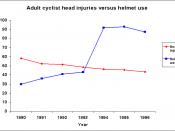A.B is a 12 year old, male who presented to the W.C.H.C E.R. department on August 24, 2005 via EMS for a head injury, that was caused by a collision with a car while he was riding his bicycle. He also had a neck appliance/brace, and a large area of bloody hair on the left side of his head, from a laceration he obtained from the accident.
Disease Process.
A head injury is any trauma that leads to injury of the scalp, skull, or brain. These injuries can range from a minor bump on the skull to a devastating brain injury. A head injury can be classified as either closed or penetrating. In a closed head injury, the head sustains a blunt force by striking against an object. A concussion is a type of closed head injury that involves the brain. In a penetrating head injury, an object breaks through the skull and enters the brain.
(This object is usually moving at a high speed like a windshield or another part of a motor vehicle.) Common causes of head injury include traffic accidents, falls, physical assault, and accidents at home, work, outdoors, or while playing sports. Some head injuries result in prolonged or non-reversible brain damage. This can occur as a result of bleeding inside the brain or forces that damage the brain directly. These more serious head injuries may cause: changes in personality, emotions, or mental abilities, speech and language problems, loss of sensation, hearing, vision, taste, or smell, seizures, paralysis and coma (Saunders, 171).
The signs of a head injury can occur immediately or develop slowly over several hours. Even if the skull is not fractured, the brain can bang against the inside of the skull and be bruised. (This is called a concussion.) The head may look...


